|
02-11-08 - Edited
and updated
Emma:
norajean.com-ramble-index
Welcome
to the list and I'm NoraJean, often referred to as NJ, and
that link
there is a collection of writings we call "rambles". Over a
period of
three years I saved those rambles that your ClayMates here
felt were
helpful in their process of learning how to get a grip on
their
clay.
The first one I hope all Newbies here will read is this
ClayArt/Beginnerish.htm
There are no questions too "beginnerish".
There's times when
beginners feel left out of the information loop.
Where what is being
discussed on lists just go right past them and
seem so complicated and
esoteric. I'm probably the worst offender
because I make up terms that
can't be found in the "usual" polymer clay glossaries.
I use the
word "cure" and not "bake" for heat setting polymer clay.
Because
there's more than one way to heat set clay.
In the oven
with a
heat gun
boiling in water
setting on a sunny window sill
(accident)
in the trunk/boot of your car (another
accident)
"Bake" makes us think of cooking food at higher
temperatures than this
clay needs.
 I use the term "raising cane"
for making a log (think jellyroll or sushi for comparison) that has
designs in it. The way I make canes is I stand clay snakes and sheets over
a picture and it's like towers raising off of a landscape.
Here's Sassy
the cat, no thumbnails yet because the section is being rebuilt. Also
I'm amused because we often are rowdy and sassy clayers. I use the term "raising cane"
for making a log (think jellyroll or sushi for comparison) that has
designs in it. The way I make canes is I stand clay snakes and sheets over
a picture and it's like towers raising off of a landscape.
Here's Sassy
the cat, no thumbnails yet because the section is being rebuilt. Also
I'm amused because we often are rowdy and sassy clayers.
 Another old tute is
how to make a "bullseye". Where you take a snake of clay and cover it with
a sheet. This makes a dot in a cane design. If you cut a bullseye up into
a bunch of sections and put them together, squeeze and pull it like taffy
you get a bunch of dots and that's called "Lace Cane".
Gold
and Black Bullseye Another old tute is
how to make a "bullseye". Where you take a snake of clay and cover it with
a sheet. This makes a dot in a cane design. If you cut a bullseye up into
a bunch of sections and put them together, squeeze and pull it like taffy
you get a bunch of dots and that's called "Lace Cane".
Gold
and Black Bullseye
Cane building
involves only snakes, sheets, and blends. New clayers tend to over think
the process. If you can press a sheet and roll a snake you're 2/3rd the
way through learning how to prep canes.
Life is not flat and two
dimensional because there's high places in the light and low places in the
shadow. There's backgrounds that are gradated in color and we have to add
dots and stripes to it. So we learn about making "blends".
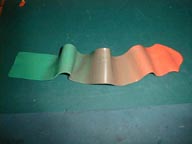 Biz-Archive/Blend-Grp.htm
A woman named
Judith Skinner came up with a technique and it's called the Skinner Blend.
It takes two overlapping colors folded in half and run it through the pasta
machine, repeated a couple of dozen times. It works. Biz-Archive/Blend-Grp.htm
A woman named
Judith Skinner came up with a technique and it's called the Skinner Blend.
It takes two overlapping colors folded in half and run it through the pasta
machine, repeated a couple of dozen times. It works.
I do blends a
little differently. Take overlapping two colors, fold them in half, press that once,
then ....roll the that sheet into a tube, mash it to a fat ribbon,
twist that ribbon like a wet wash rag, and then press. Do that six
times. It takes less time.
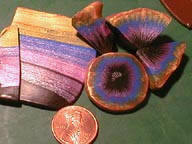
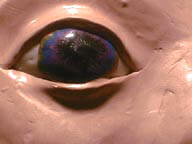 There's "loose
blends" where you twist and press 2-3 times only. It makes a variegated
design in the color. Just what you need for an
eyeball
iris. Blends that are exact are over rated. There's "loose
blends" where you twist and press 2-3 times only. It makes a variegated
design in the color. Just what you need for an
eyeball
iris. Blends that are exact are over rated.
 The other thing I'd like folks who are new to clay to
experiment with is color mixing. There's the "Color Cards" where you keep
track of your color experiments with bits of clay so you can follow your
own The other thing I'd like folks who are new to clay to
experiment with is color mixing. There's the "Color Cards" where you keep
track of your color experiments with bits of clay so you can follow your
own
record and repeat a color mix.
Biz-Archive/ColorCards/MainGroup.htm
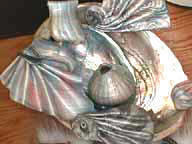 When you experiment with color you can fall across
really pretty effects like the "Abalone" effect. Using bits of color with
pearl clay. Here are some finished items that were made with the abalone
experiments. When you experiment with color you can fall across
really pretty effects like the "Abalone" effect. Using bits of color with
pearl clay. Here are some finished items that were made with the abalone
experiments.
Biz-Archive/Faux/abalone/abaPaces/2002-Done-thm.htm
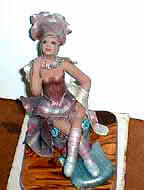
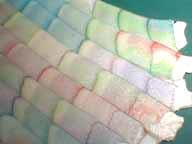 Here is
abalone colors folded and pressed going in two directions. It's a wildly
wonderful effect for little effort. Here is
abalone colors folded and pressed going in two directions. It's a wildly
wonderful effect for little effort.
FoldClay/Group-thms.htm
Make folded
abalone into clothing.
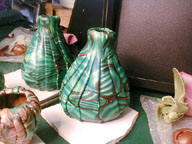 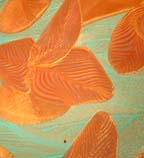 There's a bunch of things we do to play with clay
after we raise cane. There's a bunch of things we do to play with clay
after we raise cane.
We take cane slices and put them on a sheet and
press them. It makes
nice pendants and clay fabric for
figures.
Biz-Archive/Sheets/Group-thm.htm
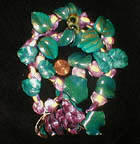 If you're into 3-D items and jewelry check out what cane
slices done as flower and leaves can make. The Wisteria-Lei from our Fiji
Month experiments. ClayMates, I gave this to Sally yesterday for Jewish
New Year and she LOVED it. Wore it all day.Wisteria/Wist-Lei/Thms.htm If you're into 3-D items and jewelry check out what cane
slices done as flower and leaves can make. The Wisteria-Lei from our Fiji
Month experiments. ClayMates, I gave this to Sally yesterday for Jewish
New Year and she LOVED it. Wore it all day.Wisteria/Wist-Lei/Thms.htm
The
biggest thing you need to do right now Emma... is please yourself.
Find
the colors you love, the subjects you love, and while you're
learning
the basic techniques and mixing colors for your color cards,
please
YOURSELF first. Don't let anything that anyone else says to you
spoil
the joy of discovery. Once you got a grip on your clay
techniques, then
you can think of doing things for other people, or
doing things for
sale. But as it is said in "Dune"
"The beginning is a delicate
time"
I'm here to encourage you and give you any help I can in the
beginning
and the first thing I want all new clayers to become is
SASSY. It's
your time, it's your muse, it's your business what you make
and no one
can tell you different.
And if they try to bum your
high... you tell them
Go follow your own bliss in that Joseph
Campbell sort of way, go goose
your own muse
for that's what
you're doing and that's all that matters at your
work
table.
Welcome aboard honey, and above all... have fun. If
it ain't fun, it's
work.
xoxo
NJ | 